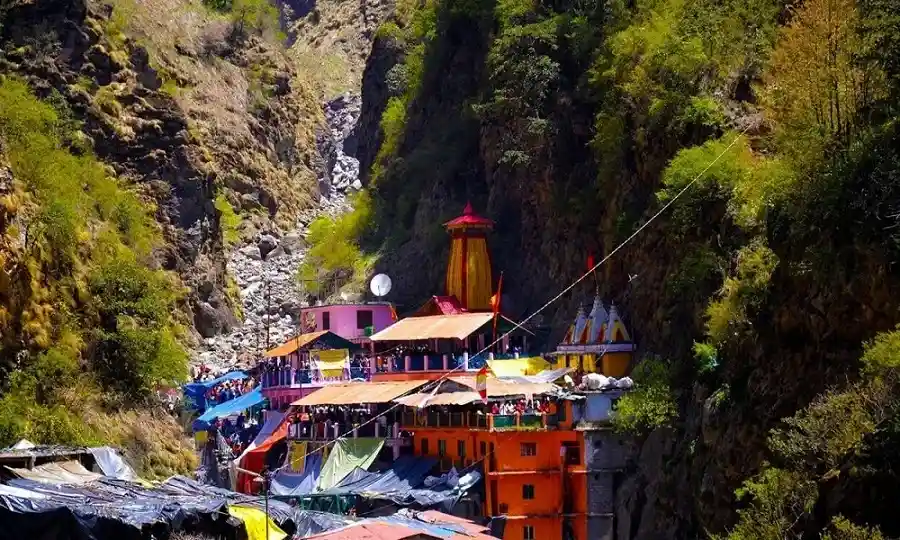As the name suggests, this ancient and sacred temple is dedicated to Goddess Yamuna, and the temple here marks the emergence point of the holy river Yamuna from its source. Since the rest of the way heading to the glacier is extremely narrow and normal people won’t be able to reach it, the temple marks the starting point of this holy river. Surrounded by the lush moss-covered green rolling hills and cascading waterfalls, which create a dramatic effect in the whole area, Yamunotri Dham is known for being the point of commencement for the Chota Char Dham Yatra of Uttarakhand. The entire region is dotted with numerous naturally occurring thermal springs, and the main temple can be reached after covering a walking distance of 4 to 5 km from the last Motorhead.

Location
Perched on an elevation of 3,293 meters above sea level and located within the district of Uttarkashi, Yamunotri Dham is one of the most difficult treks to take. The temple is located at a distance of 13 km from Hanuman Chatti and a walking distance of 6 km from Janki Chatti. You will be able to experience the breathtaking beauty and purity of the Garhwal Himalayan ranges, covered with lush green shrubs, meadows, and forests. The place requires the pilgrims to be courageous and cover the difficult trekking distance from its last motorable road.
Temple Architecture
The temple is known for its extremely contrasting yellow roof, which has become a landmark image for Yamunotri Dham. The temple is constructed using a simple and humble Indian Nagar pattern of architectural style. The current temple structure was built by the popular Garhwal ruler, Tehri Naresh Sudarshan Shah, in 1839 AD. It is constructed utilizing the granite stones that were sourced from the nearby and surrounding mountain sides. The famous glistening yellow roof of Yamunotri is conical-shaped. The main entrance of the temple structure is joined with a small porch-sized structure, which only adds to the beauty of the temple as a whole.
Inside the Temple
The idol of the presiding deity is in the form of an irregular black, gleaming stone, and it remains adorned with garlands and flowers. The idol is placed inside the Garbha Griha or the core chamber. Another feature inside the temple is the presence of a Mandap, or commonly referred to as an assembly hall, where the pilgrims get together for prayer purposes and Darshan of the goddess.
Opening and Closing Dates
Opening Dates – The temple of Yamunotri opens up for Darshan to the pilgrims during the auspicious eve of Akshay Tritiya during April or May. This year, the temple Kapat is set to open up for Darshan on 30 April 2025.
Closing Dates – Yamunotri Dham shuts down for Darshan on the holy occasion of Bhai Dooj. This year, the closing dates have been confirmed to be on 23 October 2025.
Winter Abode
After the shutdown of Yamunotri Dham, the idol of the presiding deity of goddess Yamuna is transferred to her winter home in Kharsali, which is situated at a comfortable distance of merely 20 to 30 minutes. The goddess stays there for the entire time the temple is shut down, and pilgrims can visit this temple to offer their prayers to the goddess as a part of their winter Char Dham Yatra of Uttarakhand. The idol is brought back to the main temple shrine on the opening dates of the temple during April, amongst great zeal, enthusiasm, and music of the local people.
Temple Timings Puja Rituals
The temple opens up early in the morning at 6:00 am and remains open for Darshan till 8:00 pm at night.
There are several Poojas performed inside the temple, like Mangal Aarti during the morning and for evening Aarti – Shayan Aarti. A puja kit is easily available close to the main temple, which you can buy and use to perform your puja rituals. The priests of the temple come from the nearby village of Kharsali, which is located close to Janki Chatti.
Best Time to Visit
Being situated at a whopping height, Yamunotri Dham experiences extreme weather conditions just like every other Char Dham site destination of Uttarakhand. Visiting Yamunotri Dham during its opening time in April is considered to be the best time to visit in case you want to experience its pure spirituality, devotion, and reverence for the goddess. The best time to visit is considered to be the months of April to June. Remember not to make any plans to visit the Dham during the monsoon months of July to September, since the entire region remains prone to unexpected landslides along with heavy and torrential rainfall.



 Call
Call WhatsApp
WhatsApp Enquiry
Enquiry